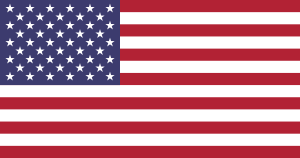Congress Adopts Plan for Future U.S. Flags, 1818
At first it was easy. 13 States. 13 Stars. 13 Stripes.Then Vermont and Kentucky entered the Union. 15 States. 15 Stars. 15 Stripes. Then came Tennessee, Ohio, Louisiana, Indiana, and Mississippi. Uh oh.
For awhile the flag was left at 15 stars and 15 stripes, but in 1818, seeing where this was headed, Congress passed a resolution that our flag would have 13 stripes, to honor the original 13, with 20 stars, to reflect the current number of states. A star would be added each time another state joined the Union. The new flag would be come official on the July 4th following the admission of the state to the United States.
The last change to the flag occurred in 1960, following the admission of Hawaii on August 21, 1959. Since Alaska had been admitted on January 3, 1959, the 49-star flag was only official for one year. Prior to the admission of these last two states, over 1500 designs were submitted to President Eisenhower for consideration by citizens of the United States, several of them being identical to the 50-star flag that was finally adopted. One such design was submitted by at 17-year-old high school student and designed for a school project. He got a B-.
 |
| Tad Lincoln |
Tad Lincoln's Birthday, 1853
When the family moved to the White House, Tad was only eight. He appears to have been a very hyperactive child, always running about, playing war games, and interrupting meetings. He did not attend school, and was tutored in the White House, often to the despair of his teachers. He had a pronounced lisp, and may have had a cleft palate.
Tad was attending a performance of Aladdin and the Wonderful Lamp with his tutor at the Groves Theater on April 14th, while his parents were at Ford's Theater seeing Our American Cousin. When the news that the President had been shot was announced, Tad was distraught, running around the theater shouting, "They killed Papa! They killed Papa!"
 |
| Tad at age 18 |
Tad died of what was called by doctors "compression of the heart" (probably tuberculosis) when he was only 18. He was buried in Springfield with his father and two of his brothers.
 |
| The first Peace Badge, 1958. |
The Peace Symbol Displayed in London, 1958
The familiar peace symbol was created by Gerald Holtom for a peace march from Trafalgar Square to the Atomic Weapons Research Establishment on April 4, 1958. The march was organized by the Direct Action Committee and supported by the Campaign for Nuclear Disarmament.The symbol is generally considered to have been created as the combination of the semaphore signals for N and D, standing for Nuclear Disarmament. In semaphore, the N is signaled by a person holding two flags in a downward diagonal position, and the D is signaled by one flag going straight up and the other straight down. Superimposing these two signals gives you the peace symbol.
 |
| Holtom based it on this painting, although the hands are going the wrong way. |
The symbol was adopted by the Campaign for Nuclear Disarmament and later was imported to the United States, where it became a generic symbol of the peace movement. By the end of the 1960's it was recognized all over the world.

No comments:
Post a Comment